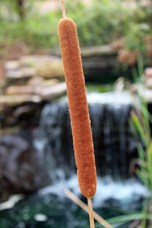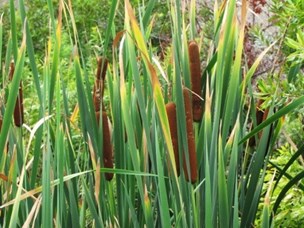

Mississippi Native: Cattails
(Typha species)
Downloadable Brochure: CATTAILS
Other Name/s:
There are two types of cattails – the broadleaf (Typha latifolia) and the narrowleaf (Typha angustifolia). Each is distinguished from the other by their leaves as their names suggest.
Description/Season:
This clumping plant has long, green leaves. Flower spikes, known as catkins, appear in the spring. They are yellow/green before turning brown. In the fall, seeds (white fluff) appear.
Size:
Cattails can reach heights of 7 or 8 feet.
Habitat:
This plant is found in areas with shallow water, particularly in areas that are prone to flooding.
Interesting Facts:
The cattail has many wildlife benefits – food and habitat for birds, mammals, and fish. Every part of the plant is edible. Native Americans used cattails for food, bedding, roofs, and other day-to-day items, including sandals and floor mats. The Native Americans also used roots for treating burns, inflammations, and stomach illnesses. For life vests, the U.S. Navy used the seeds as a filler material. Cattails are used in flower arrangements and are frequently seen in water gardens.
Planting Tips:
Divide roots or plant from seeds. Cattails need full sun to part shade. Plant in areas where the plant is not completely submerged. Cattails multiply quickly, forming clumps. These plants fair well in marshy areas or low areas with standing water.









